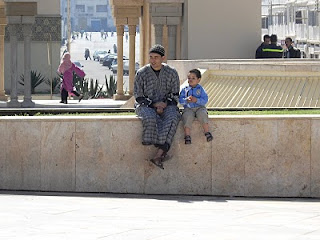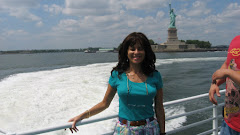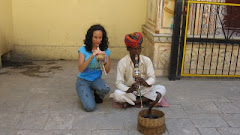






Granada and the Great Alhambra “The Pearl Set in Emeralds”
Today, we took a tour with SpainDaytours to visit The Magnificent Alhambra, a 1.5 hour drive from the port of Malaga, Spain.
The Alhambra palace, the greatest Moorish palace in Europe, was built for the last Muslim Emir during the mid-14th century.
The complex demonstrates the grandeur of the Moorish civilization of Andalusia with its signature features including busy stucco, plaster "stalactites," colors galore, scalloped windows framing hillside Granada views, exuberant gardens, and water, water everywhere. Water — so rare and precious in most of the Islamic world — was the purest symbol of life to the Moors-so, the Alhambra is abundantly decorated with water: standing still, cascading, masking secret conversations and drip-dropping playfully.
At one time, 2000 Muslims lived inside the Alhambra walls
The Alhambra in Four Parts
The Alhambra consists of four sights clustered together atop a hill: 1. The (Non-Moorish) Charles V's Palace (Christian Renaissance palace plopped on top of the Alhambra after the reconquest), 2. Alcazaba (fort with tower and views), 3. Palacios Nazaries (exquisite Moorish palace, (the jewel of the tour), and 4. Generalife (beautiful, lush gardens and summer palace).
1. Charles V's Palace
Conquering kings often built their own palaces over their foe's palace, and that's exactly what the Christian king Charles V did. The Palacios Nazaries wasn't suitable for Charles, so he built this new home, considered Spain's most impressive Renaissance building, on top of it. Charles' palace was designed to have a dome, but it was never finished. His son, Philip II, abandoned it to build his own palace, El Escorial. Yes, it’s another case of pure European royal greed and waste.
We visited the adjacent Museo de la Alhambra, showing off some of the Alhambra's best surviving Moorish art, along with one of the lions from Palacios Nazaries' fountain (under construction till 2012).
2. Alcazaba
The fort — the original "red castle" or "Alhambra" — is the oldest and most ruined part of the complex, offering spectacular city views. At one time, this tower defended a town (or medina) of 2,000 Muslims living within the Alhambra walls.
Of note, in the 19th century, Napoleon stationed his troops at the Alhambra, contributing substantially to its ruin when he left.
3. Palacios Nazaries, the Moorish royal palace
At 1:30, the entry time slot stamped on our tickets, we entered the jewel of the Alhambra: the Moorish royal palace, Palacios Nazaries, built primarily in the 14th century. We toured three basic sections: royal offices, ceremonial rooms, and private quarters.
We visited rooms decorated from top to bottom with carved wood ceilings, stucco "stalactites," ceramic tiles, molded-plaster walls, and filigree windows. Open-air courtyards in the palace feature fountains with bubbling water like a desert oasis, the Quran's symbol of heaven. The palace is well-preserved, but the trick is to imagine it furnished and filled with Moorish life...sultans with hookah pipes lounging on pillows on Persian carpets, tapestries on the walls, heavy curtains on the windows, and ivory-studded wooden furniture. The whole place was painted with bright colors, many suggested by the Quran — red (blood), blue (heaven), green (oasis), and gold (wealth). And throughout the palace, walls, ceilings, vases, carpets, and tiles were covered with decorative patterns, mostly calligraphy writing out verses of praise from the Quran.
As I wandered, I kept the palace themes in mind: water, no images, "stalactite" ceilings, and jagged pathways that zigzag (to prevent enemies from storming the place).
We toured Court of Myrtles (Patio de los Arrayanes); Boat Room (Sala de la Barca); Court of the Lions (Patio de los Leones); The Hall of the Ambassadors (Gran Salón de Embajadores); Hall of the Two Sisters (Sala de Dos Hermanas); the Hall of the Abencerrajes (Sala de los Abencerrajes); Court of the Lions (Patio de los Leones); and The Hall of the Kings (Sala de los Reyes)
Here are highlights of three of them:
The Hall of the Ambassadors (Gran Salón de Embajadores):
During the 15th century, a visitor here would have stepped from the glaring Court of Myrtles into this dim, cool, incense-filled world, to meet the silhouetted sultan.
There is finely carved Arabic script throughout. Muslims are forbidden from making images of living creatures — that is God's work. Instead, they are allowed to display decorative religious messages. One phrase — "only Allah is victorious" — is repeated 9,000 times throughout the palace.
In 1492, two historic events likely took place in this room.
1.Culminating a 700-year-long battle, the Reconquista was completed here as the last Moorish king, Boabdil, signed the terms of his surrender before eventually leaving for Africa.
2.Columbus made his pitch to Queen Isabel and King Ferdinand to finance a sea voyage to the Orient, making his case that he could sail west to reach the East. Although most in the audience of the greatest minds from the University of Salamanca scoffed and called him mad, Queen Isabel said "Sí, señor."
Court of the Lions (Patio de los Leones):
This patio, the Patio de los Leones, features a fountain that's usually surrounded by 12 lions. One of the lions is on display in the Museo de la Alhambra inside the Charles V palace, while the others were under construction.
Why did the fountain have 12 lions? Since the fountain was a gift from a Jewish leader celebrating good relations with the sultan (Granada had a big Jewish community), the lions represent the 12 tribes of Israel. During Moorish times, the fountain functioned as a clock, with a different lion spouting water each hour. (Conquering Christians disassembled the fountain to see how it worked, and it's never worked since.)
Washington Irving Room:
We visited the room marked with a large plaque “where Washington Irving wrote Tales of the Alhambra”. While living in Spain in 1829, Irving stayed in the Alhambra. His "tales" re-kindled interest in the place, causing it to become recognized as a national treasure. A plaque on the wall thanks Irving, who later served as the US ambassador to Spain (1842–1846). Here's a quote from Irving's "The Alhambra by Moonlight": "On such heavenly nights I would sit for hours at my window inhaling the sweetness of the garden, and musing on the checkered fortunes of those whose history was dimly shadowed out in the elegant memorials around."
Washington Irving is virtually celebrated as the contemporary patron saint of Granada because his writings sparked renewed worldwide interest in The Alhambra.
4. Generalife Gardens and Summer Palace
It is considered the most perfect Arabian garden in Andalucía. Generalife, (the sultan's vegetable and fruit garden and summer palace), is a short hike uphill near the palace. The 2,000 residents of the Alhambra enjoyed the fresh fruit and veggies grown here. Most importantly, the sultan enjoyed a quiet escape from a busy life governing in the summer. Of note, the Sultan never stayed overnight (security concerns).
This summer home of the Moorish kings, the closest thing on earth to the Quran's description of Heaven, was planted over 600 years ago — remarkable longevity for a European garden.
Many tourists never get to see the Alhambra because entry is limited and tickets sell out quickly. The Alhambra admits 7,800 visitors a day. Six thousand tickets are sold in advance and the rest are sold each day early at the Alhambra ticket window. The Alhambra complex's top sight is the Moorish palace — Palacios Nazaries. Only 300 visitors per half hour are allowed to enter there. Tickets cost 12Euros in March 2011.
Next time, I will visit after May when all the flowers are in full bloom!








































.jpg)
.jpg)



